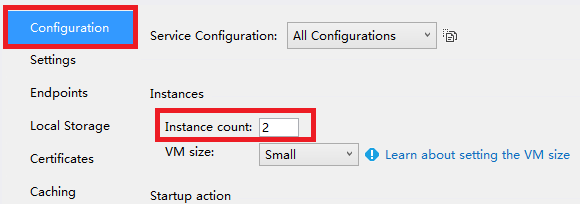《Windows Azure Platform 系列文章目录》
Update 2016-01-12
https://azure.microsoft.com/zh-cn/documentation/articles/cache-dotnet-how-to-use-in-role/
微软宣布Azure Managed Cache Service和Azure In-Role Cache会在2016年11月30日下线,建议所有的用户采用Redis Cache。
有关Redis Cache的内容,请参考:
http://www.cnblogs.com/threestone/category/741409.html
笔者很早以前就想写这篇文章了,昨天晚上项目正好遇到,今天记录下来。
为什么要使用In-Role Cache?
我们在开发PaaS Cloud Service的时候,PaaS VM都是无状态的。而且默认的Load Balancer是5要素(source IP, source port, destination IP, destination port, protocol type)
http://azure.microsoft.com/blog/2014/04/08/microsoft-azure-load-balancing-services/
如果遇到需要保留Session,使用Cache的时候,就会遇到一些问题。这时候,我们就可以使用In-Role Cache了。
In-Role Cache介绍
In-Role Cache分为两种方式:
- Co-located Role(共享模式)。在共享模式中,Caching是保存在多个Web Role Instance的内存中。
- Dedicated Role(专用模式)。在专用模式中,用户需要在工程文件中新建额外的Cache Worker Role,Caching不保存在Web Role VM的内存中,而是保存在新建的Cache Worker Role中。
因为使用Dedicated Role,需要增加额外的Cache Worker Role,会增加计算成本
如何使用In-Role Cache?
1.In-Role Cache不能在Virtual Machine虚拟机中使用,只能在PaaS Cloud Service使用。
2.In-Role Cache不是通过Azure Management Portal创建的,而是安装完Azure SDK后,在Cloud Project中配置的。
注意:本章介绍的是Co-located Role(共享模式)。
Co-located Role的架构图,请参考http://weblogs.asp.net/scottgu/meet-the-new-windows-azure

1.使用管理员身份,运行Visual Studio 2013,创建一个新的Cloud Project,命名为LeiColocatedRole。图略。
2.在New Windows Azure Cloud Service中,只需要添加ASP.NET Web Role。如下图:

3.我们在项目文件中,选择WebRole1,右键,属性

4.在Configuration栏目中,将Instance Count设置为2,设置2个Web Role Instance做高可用,如下图:

5.在Caching栏目,修改以下红色部分

(1)勾选Enable Caching,启用In-Role Caching
(2)点击Co-located Role,并且在Cache Size中,设置内存比,即PaaS Web Role Instance的30%内存用来保存Caching信息
(3)设置Storage Account,因为Cache Cluster(PaaS Web Role Instance)会将Runtime的信息保存在Storage,所以这里一定要设置正确
(4)Named Cache默认是default,我们可以通过Add Named Cache,增加新的Cache Name。
另外,笔者在步骤4设置了Instance Count=2,所以我们可以勾选High Availability,保证高可用。这样不会因为某台Web Role Instance因为故障宕机导致Caching丢失
(如果Instance Count=1的话,是无法勾选High Availability)
6.然后我们点击WebRole1,右键,Manage NuGet Packages

7.查找关键字Windows Azure Cache,查询到结果后,点击下图的Install进行安装

8.安装完NuGet之后,会发现WebRole1项目下,增加了以下的引用:

如果你使用ASP.NET,还会增加引用:Microsoft.Web.DistributedCache.dll
9.我们修改WebRole1下的Web.config,找到autoDiscover节点,如下图:

将上图中的[Cache role name or Service Endpoint]中的节点,修改为项目文件的RoleName,在笔者的Sample Code中,我们设置为WebRole1
设置完毕后的结果如下图:

10.将ASP.NET的Session指向Cache
最后我们在Web.Config节点中,将sessionState节点的注释去掉。如下图:

注意:如果在步骤5中,修改了默认的Named Cache "default",我们需要在上面的XML节点中,将dataCacheClientName的节点,修改为我们自定义的Cache Name。如上图红色部分:
11.使用In-Role Cache
在C#代码中,增加using语句:
using Microsoft.ApplicationServer.Caching;
声明DataCache
static DataCache myCache;
实例化
myCache = new DataCache("default");
写Cache
myCache.Put("MyKey", TextBox1.Text);
读Cache
string outputFromCache = myCache.Get("MyKey") as string;
参考资料:http://blog.sanc.idv.tw/2012/06/windows-azure-windows-azure-co-located.html




 浙公网安备 33010602011771号
浙公网安备 33010602011771号